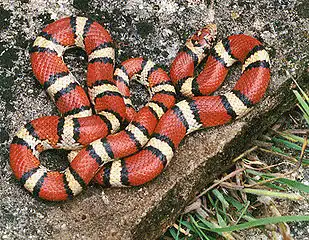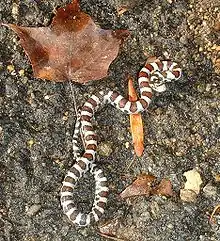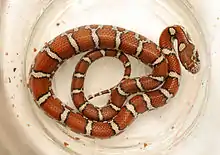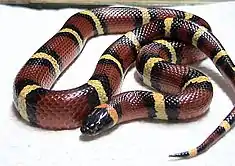Milk snake
Lampropeltis triangulum, commonly known as the milk snake or milksnake, is a species of kingsnake; 24 subspecies are currently recognized. Lampropeltis elapsoides, the scarlet kingsnake, was formerly classified as the subspecies L. t. elapsoides, but is now recognized as a distinct species.[1] The subspecies have strikingly different appearances, and many of them have their own common names. Some authorities suggest that this species could be split into several separate species.[1] They are not venomous to humans.[2][3]
| Milk snake | |
|---|---|
 | |
| Red milk snake (Lampropeltis triangulum syspila) | |
| Scientific classification | |
| Kingdom: | Animalia |
| Phylum: | Chordata |
| Class: | Reptilia |
| Order: | Squamata |
| Suborder: | Serpentes |
| Family: | Colubridae |
| Genus: | Lampropeltis |
| Species: | L. triangulum |
| Binomial name | |
| Lampropeltis triangulum | |
| Subspecies | |
|
24 subspecies, see text | |
| Synonyms | |
| |
Geographic range
They are distributed from southeastern Canada through most of the continental United States to Central America, south to western Ecuador and northern Venezuela in northern South America.[1][4]
Description
Milk snakes commonly exceed 60 cm (24 in) in total length (including tail), with very large specimens known to reach total lengths of 120 to 132 cm (47 to 52 in).[1][5] They appear to be one of the smaller species of the kingsnake genus, as adults in the wild apparently average from 38 to 225 g (1.3 to 7.9 oz) in North America and most typically do not exceed a total length of 90 cm (35 in). However, unusually large milk snakes can become rather bulkier than average-sized adults and potentially weigh up to 750 to 1,400 g (1.65 to 3.09 lb), though high weights as such are generally reported from captivity.[6][7][8] Males typically are larger than females in maturity, although females can be bulkier than males similar in length, as well.[9] Generally more tropical populations, from Mexico and further south, reach larger adult sizes than milk snakes living in the temperate zones.[10] They have smooth and shiny scales and their typical color pattern is alternating bands of red-black-yellow or white-black-red.[1] However, red blotches instead of bands are seen in some populations.[1] Some milk snakes have a striking resemblance to coral snakes, in Batesian mimicry, which likely scares away potential predators. Both milk snakes and coral snakes possess transverse bands of red, black, and yellow. Experts now recognize that common mnemonics that people use to distinguish between the deadly coral snake and the harmless milk snake are not 100% reliable. Some coral snakes do not have the typical banding colors or patterns.[11] Examples of unreliable mnemonics commonly used:


Due to the many colors of the eastern milk snake (L. t. triangulum), it can resemble the coral snake, corn snake, fox snake, scarlet snake, and most importantly, the venomous snake genera Agkistrodon and Sistrurus. Milk, fox, and scarlet snakes are killed because of a resemblance to the venomous pygmy rattlers. Juvenile milk snakes, which are more reddish than adults, are often killed because they are mistaken for copperheads. Enough distinction exists among the five to make the eastern milk snake fairly easy to identify. The eastern milk snakes also have a light-colored, V-shaped or Y-shaped patch on their necks. One subspecies is melanistic (almost all black).[1]
Habitat
Across the wide range of this species, habitat varies. Typically, milk snakes live in forested regions; however, in some regions, they can be located in open prairies. In various parts across their distribution, milk snakes often live on rocky slopes.[1] In some situations, milk snakes also migrate seasonally, during the winter they move to higher and drier habitats for hibernation and moister habitats for the summer. Milk snakes enter hibernation from late October or November to mid-April.[14]
Behavior
Milk snakes are mostly nocturnal especially during summer months.[14] They are primarily terrestrial and attempt to blend in with ground litter. They tend to be secretive and remain hidden. When threatened, a milk snake will usually first try to escape. If cornered or harassed, it may vibrate its tail and strike energetically, though of course they are non-venomous, have only tiny teeth and their tails lack a rattle. Unless frightened, milk snakes move slowly. They are able to climb and swim.[15]
Diet
Young milk snakes typically eat slugs, insects, crickets, and earthworms.[16] Adults' diet frequently includes lizards (especially skinks), and small mammals.[1] Juveniles in the western United States generally feed on small lizards.[6] They are also known to eat birds and their eggs, frogs, fish, and other snakes.[16]
Milk snakes are much more opportunistic eaters than the fox snake or corn snake. They have been known to consume a variety of animals, including rodents, eggs, birds, reptiles, amphibians, and invertebrates. Nevertheless, the diet of an adult milk snake still primarily consists of rodents.[6] They are nocturnal eaters and are often found during the day in old barns and under wood.
An early myth about milk snakes is that they suck cow udders to get the milk. The myth is entirely false, and is discredited by the fact that the milk snake does not have the physical capabilities to suck milk out of a cow. Milk snakes are, however, frequently found in and around barns, making use of their cool and dark environments, and for the easily accessed populations of rodents to feed on. This proximity to barns, and therefore cows, probably gave rise to the myth.[1]
Reproduction
Milk snakes are oviparous, laying an average of about 10 eggs per clutch, although that number may vary by region.[1] The milk snake mates from early May[16] to late June. In June and July, the female lays three to 24 eggs beneath logs, boards, rocks, and rotting vegetation.[16] The eggs are oval in shape, and white in color. Eggs range from 2.5 cm to 4.2 cm (1 to 1.7 in) in length.[14] The eggs incubate for about two months, and hatch around August or September.[16] Milk snakes typically live around 12 years, or up to 21 years in captivity.[16] They reach their maturity within three or four years.[14] The average hatchling in Virginia measures 20.9 cm (8.2 in) in total length and weighs 4.1 g (0.14 oz).[17]
Conservation status
The milk snake is listed as of least concern by the IUCN (a wildlife conservation union),[18] but in some areas, they may face significant pressure due to pet-trade collection.[1] Because of this species' attractiveness in the pet trade, many subspecies are now being bred in captivity for sale.[1]
Subspecies
- Guatemalan milk snake, L. t. abnorma (Bocourt, 1886)
- Louisiana milk snake, L. t. amaura (Cope, 1861)
- Andean milk snake, L. t. andesiana (K.L. Williams, 1978)
- Mexican milk snake, L. t. annulata (Kennicott, 1861)

- Jalisco milk snake, L. t. arcifera (Werner, 1903)
- Blanchard's milk snake, L. t. blanchardi (Stuart, 1935)
- Pueblan milk snake, L. t. campbelli (Quinn, 1983)
- New Mexico milk snake, L. t. celaenops (Stejneger, 1903)
- Conant's milk snake, L. t. conanti (K.L. Williams, 1978)
- Dixon's milk snake, L. t. dixoni (Quinn, 1983)
- black milk snake, L. t. gaigeae (Dunn, 1937)
- Central Plains milk snake, L. t. gentilis (Baird & Girard, 1853)
- Honduran milk snake, L. t. hondurensis (K.L. Williams, 1978)
- pale milk snake, L. t. multistriata (Kennicott, 1861)
- Nelson's milk snake,[20] L. t. nelsoni (Blanchard, 1920)
- Pacific Central American milk snake, L. t. oligozona (Bocourt, 1886)
- Atlantic Central American milk snake, L. t. polyzona (Cope, 1861)
- Sinaloan milk snake, L. t. sinaloae (K.L. Williams, 1978)
- Smith's milk snake,[20] L. t. smithi (K.L. Williams, 1978)
- Stuart's milk snake, L. t. stuarti (K.L. Williams, 1978)
- red milk snake, L. t. syspila (Cope, 1889)
- Utah milk snake, L. t. taylori (W.W. Tanner & Loomis, 1957)
- eastern milk snake, L. t. triangulum (Lacépède, 1788)
References
- Savitzky, Alan H. (2004), Hutchins, Michael; Evans, Arthur V.; Jackson, Jerome A.; Kleiman, Devra G. (eds.), Grzimek's Animal Life Encyclopedia, 7: Reptiles (2nd ed.), Detroit: Adam, p. 47, archived from the original on 2011-05-21, retrieved 2018-12-03
- Web, Animal Diversity. "BioKIDS – Kids' Inquiry of Diverse Species, Lampropeltis triangulum, Scarlet kingsnake". www.biokids.umich.edu.
- "Snakes of New York". SUNY College of Environmental Science and Forestry.
- Armstrong, Michael P.; Frymire, David; Zimmerer, Edmund J. (December 2001), "Analysis of sympatric populations of Lampropeltis triangulum syspila and Lampropeltis triangulum elapsoides, in western Kentucky and adjacent Tennessee with relation to the taxonomic status of the scarlet kingsnake", Journal of Herpetology, 35 (4): 688–93, doi:10.2307/1565915, JSTOR 1565915
- Fischer, L. (2002). COSEWIC status report on the Milksnake Lampropeltis triangulum in Canada in COSEWIC assessment and status report on the Milksnake Lampropeltis triangulum in Canada. Committee on the Status of Endangered Wildlife in Canada. Ottawa, 1-29.
- Hamilton, B. T., Hart, R., & Sites, J. W. (2012). Feeding ecology of the Milksnake (Lampropeltis triangulum, Colubridae) in the western United States. Journal of Herpetology, 46(4), 515-523.
- Fitch, H. S. (1982). Resources of a snake community in prairie-woodland habitat of northeastern Kansas. Herpetological communities, 83-97.
- Peterson, K. H., Lazcano, D., & Galván, R. D. J. (1995). Captive reproduction in the Mexican milksnake Lampropeltis triangulum annulata. Litteratura Serpentium, 15(5), 128-132.
- Shine, R. (1994). Sexual size dimorphism in snakes revisited. Copeia, 326-346.
- Williams, K. L. (1994). Lampropeltis triangulum. Catalogue of American Amphibians and Reptiles (CAAR).
- "The Most Common Myths About Coral Snakes | The Venom Interviews". thevenominterviews.com. Retrieved 2018-10-07.
- "Frequently Asked Questions". South Carolina Department of Natural Resources. (see FAQ's. -- "are there any visual clues"..........). Archived from the original on 2017-12-30.
- Medical-Surgical Nursing: Patient-Centered Collaborative Care by Donna D. Ignatavicius, M. Linda Workman (page 125s)
- Harding, James; Mifsud, David (2017). Amphibians and Reptiles of the Great Lakes Region. Ann Arbor, MI: University of Michigan Press. doi:10.3998/mpub.8158052. ISBN 978-0-472-07338-2.
- Tennant, Alan. (2003). Snakes of North America : eastern and central regions. Lone Star Books. ISBN 1-58907-003-8. OCLC 632838334.
- "Encyclopedia of Animals (Milk snake entry)", EBSCO Animals, EBSCO Publishing
- Linzey, D. W., & Clifford, M. J. (2002). Snakes of Virginia. University of Virginia Press.
- "Lampropeltis micropholis". IUCN Red List of Threatened Species.
- Species Lampropeltis triangulum at The Reptile Database
- Bell, Edwin L.; Smith, Hobart M.; Chiszar, David (2003), "An Annotated List of the Species-Group Names Applied to the Lizard Genus Sceloporus" (PDF), Acta Zoologica Mexicana (90): 103–174
External links
| Wikimedia Commons has media related to Lampropeltis triangulum. |
- Milk Snake, Reptiles and Amphibians of Iowa
